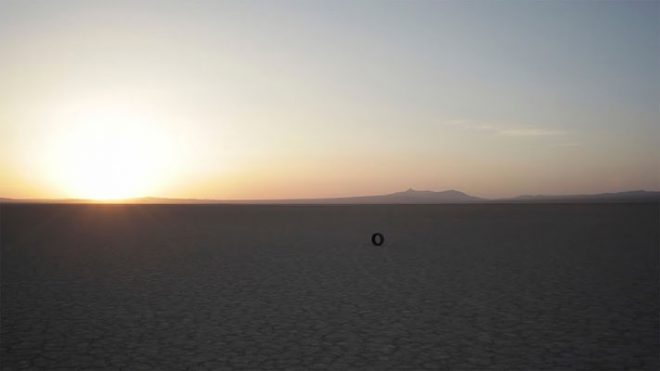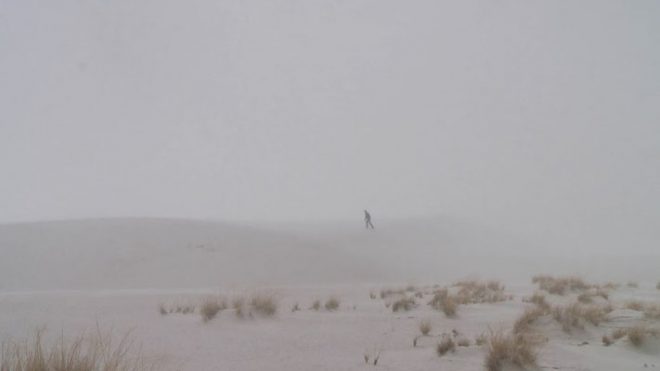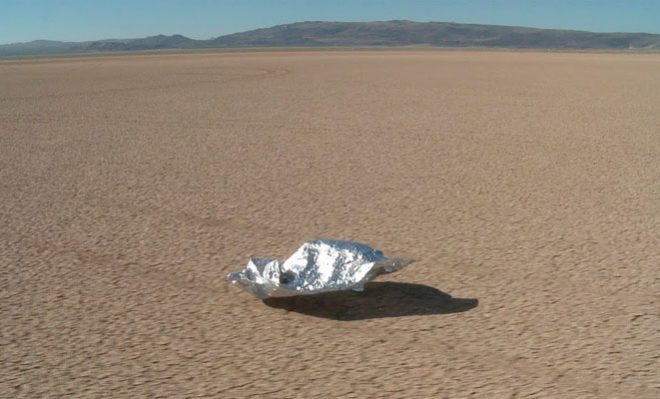The Middle Passage: William Lamson at Antenna Gallery
Benjamin Morris reviews William Lamson's exhibition “Between Now and Forever.”

William Lamson, Between Now and Forever, 2014. HD video (still). Courtesy the artist.

William Lamson, Untitled (White Sands, New Mexico), 2013. HD video (still). Courtesy the artist.

William Lamson, Untitled (Mylar Blanket), 2011. HD video (still). Courtesy the artist.
William Lamson
Press Street's Antenna Gallery
3718 St. Claude Avenue
February 8–March 2, 2014
Nel mezzo del cammin di nostra vita / mi ritrovai per una selva oscura, Dante famously wrote in the beginning of his Divine Comedy. The translations differ slightly, but the poet’s epic voyage through hell, purgatory, and heaven affirms that middles are as significant to our lives as beginnings or ends. We live most of our lives in middles—of careers, of pursuits, of relationships—with moments of great accomplishment or fissure arriving only occasionally, like unexpected trains in our station, an insight illustrated beautifully in the current show by Brooklyn-based artist William Lamson at Antenna Gallery.
Composed of three videos and two photographs, Lamson’s “Between Now and Forever” serves as an extended meditation on time. The most ambitious piece in the show, the 17-minute video Untitled (White Sands, New Mexico), 2013, consists of a tracking shot of a distant figure walking endlessly along a sand dune from right to left in the frame. At times receding, at times drawing near to the lens, at times climbing or descending, and at times nearly disappearing from sight, he never seems to reach the end of his journey. The palette, while bleak, does not descend into an easy Mad Max or Cormac McCarthy-style post-apocalypticism. Rather, shot during a sandstorm, Lamson’s coloring is soft, almost snowy, rendering the landscape of the dune almost into abstraction: this individual (actually the artist himself) could be anyone, anywhere, walking towards a destination only he knows.
Or just walking: Dantean or Sisyphean (minus the rock), the man’s journey becomes a metaphor for any effort. More recent forebears of the genre of walking-as-metaphor include Richard Long, who intended that his walks leave specific traces in a landscape, markers of his presence. But as the man’s steps here leave no trace, Lamson seems more interested in the act itself, of the way in which rhythmic, persistent effort can create meaning—call it the aesthetics of determination. The effect is oddly soothing, even reassuring. Exploring this notion further, Lamson’s other two videos in the show set inanimate objects in motion in the desiccated landscape of a dried-out lakebed in the Mojave Desert.
The first, Between Now and Forever, 2014, is a 12-minute tracking shot of a tire rolling across the landscape—again, seemingly endlessly from right to left—contrasting this motion with the imperceptible rising of the sun over a distant mountain. (The video was originally shot at sunset, with the tire rolling in the opposite direction, but then digitally reversed.) As the lens follows the tire, inevitable questions arise: _what propels it? will it fall? how long could this possibly last? _But with the camera’s steady gaze, the longer one looks, the more swiftly the tire, like the man, becomes something more—an eye, a ring, a mere circle traveling along a plane. In short, it becomes the act of inscription, even as it travels over the remnants of old tire tracks, record themselves of prior explorations.
Propelling the tire, of course, is the wind, the hidden subject of the third video in the show. Untitled (Mylar Blanket), 2011, follows the motion of a Mylar blanket blown by the wind across the same dried-out lakebed, capturing how its wild, exuberant twists and folds render the swath of silver into a living organism dancing over the backdrop of the dead earth. The video is lovely to watch, and rare and welcome indeed is the opportunity to see wind made visible, but this kind of kinetic allure has been explored before—poignant scenes in The Red Balloon (1956) and, more recently, American Beauty (1999) come to mind. That ground, in other words, feels covered. In the context of this show, however, the value of Lamson’s piece is that it depicts the remarkable textures of his lunar landscape in full, radiant sun, made even more apparent alongside the crumpled, reflective Mylar.
As in much of Lamson’s work, the show offers a range of compelling, and satisfying, tensions—figure versus ground, metaphor versus reality, motion versus stasis. Far from being mere classroom exercises, these are the struggles and questions that dwell vividly in both our imagination and our practice, and toward which, in the middle of any of our middles, we press on.
William Lamson’s “Between Now and Forever” is on view through March 2 at Press Street's Antenna Gallery (3718 St. Claude Avenue) in New Orleans.



